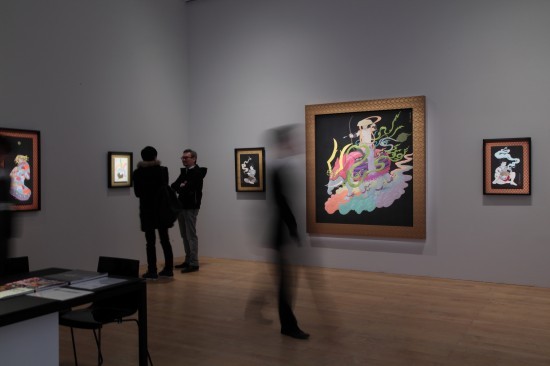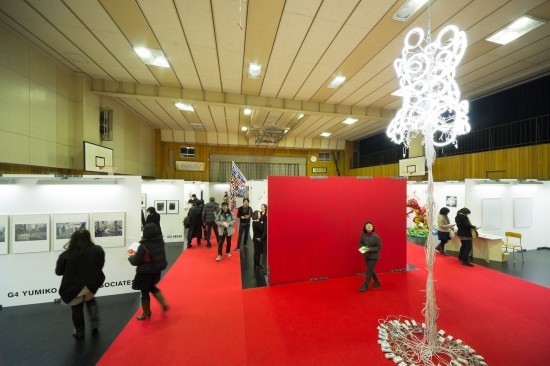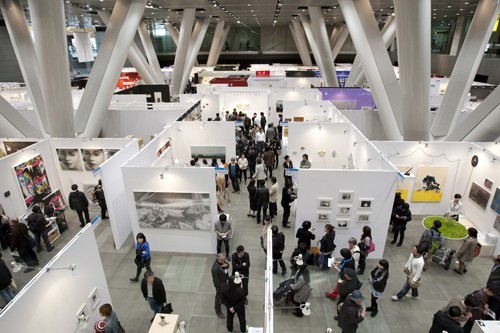Building up to the Tokyo Art Fair: G-tokyo, Tokyo Frontline and Art Fair Tokyo

Scene from G-tokyo 2011. Photo Keizo Kioku.
In the last few years, February has become the month for graduation exhibitions and art fairs. Visitor numbers have also grown and more than a few young artists have used these events as opportunities to gain attention and make their debuts, as a result of which one could probably say the Japanese art world is in the process widening its base in its own way and improving its institutional infrastructure from many different angles. Just as the G-tokyo art fair appeared to be stuck in a rut, there emerged Tokyo Frontline, which relies above all on planning, and there are high expectations for the revamped Art Fair Tokyo. If there’s still something missing it’s probably coordination in terms of the planning of exhibitions. In places like Basel and London, the art fair season is when the city art museums and galleries present their showpiece exhibitions. Tokyo doesn’t yet have this level of synchronization. Perhaps it should be said that the not unexpected unwillingness of bureaucrats to adjust to the “out of office” phenomenon also applies to the world of art museums. The fact that the Joint Graduation Exhibition of Five Art Universities in Tokyo could be held at the National Art Center, Tokyo, therefore, was probably due to the fortuitous availability of rental space, although it was significant in the sense that it provided a showcase just when the target audience was together in one place. In contrast, the selection for the Takahashi Collection Hinode opening exhibition, “The Most Requested Top 30 – 10 Years of Takahashi Collection” (at Tabloid Gallery), with works from the collection that were considered to be representative of Japanese contemporary art since the advent of Neo-pop was a move designed to appeal to overseas guests in light of the fact that art fairs in this country are prone to become campaigns for domestic enlightenment.

Tokyo Frontline 2011. Photo Takumi Ohta.
However, even as the institutional exterior framework approaches some kind of international standard, another problem relating to international standards surfaces in that although the vessel may have attained significance, the same cannot be said of the contents. For argument’s sake, let’s divide the art one often sees at art fairs here and overseas into four broad categories from the standpoint not of the maker but of the viewer. These are A) types that rely on the artworks themselves (objects, actions, or concepts, usually labeled with the name of some kind of movement); B) types that rely on something other than the artworks (discourse “about” or interpretations “of” art); C) types that do something different from other people (artist-specificity in terms of something unprecedented or something only that person can do); and D) types that do the same thing as other people (collectivity in the form of déjà vu or something anyone can do). There are four possible combinations based on the formula A/B x C/D. However, there are two caveats. Because in the final analysis there are no artworks that do not incorporate some kind of inquiry into art, the distinction between A and B is made not by the artist but by the audience. To use a metaphor, this is similar to the distinction between A) whether the actual food presented to one is tasty or not is important, or B) whether the chef’s stock of knowledge regarding the food is important (the art world would appear to be dominated by people with unrefined palates who find anything tasty as long as it’s presented along with a stock of knowledge). Furthermore, what distinguishes C from D is neither the technical skill of the artist nor whether the artist is an individual or a group, but the “quality” as perceived by the viewer, or in other words the difference between whether the viewer responds to something that is different from themselves or identifies with something familiar.
Bearing in mind the above caveats, as a rule those viewers whose palates are not “unrefined” would probably support A x C. When it comes to criticism, too, it is difficult to imagine any other alternative. This is because whether criticism is good or bad depends not on resolving A into B but commenting on a work’s “taste” according to A and C. This always puts critics in the minority. One may think that A x D is a contradiction, but the “best-sellers” at art fairs generally fall into this category. This is the lamentable yet fascinating phenomenon widely seen at art fairs all over the world in which works that have an element of déjà vu generally sell better than others. People are reluctant to spend money on unfamiliar work that people cannot understand. This is why work that is familiar, exhibits a certain degree of technical variation and falls within the appropriate price range sells. This is the territory of second-string artists and second-string galleries.
The B group vaguely corresponds to such labels as “conceptual,” and is where people brainwashed into believing in the Modern utopia of non-institutional art (art as art criticism; “externally” oriented art) tend to congregate. In a similar vein, the form assumed by B x D is often discourse “about” art based on new media, a recent example of which is new art born out of the sensibility of using media such as Facebook and Twitter. One of the symptoms typical of the utopian orientation is the projection onto new media of images of “liberation” and “freedom.” This is why new media art is so often constricted to “indeterminate” images such as “chaos,” “impulsion” and “proliferation” in a way that can only be described as “uniform” or “symptomatic.” The same old stale wine is presented in new wineskins. On the other hand, whether it’s early electronic music or raves, the excessiveness of new art has been born out of the irregular use of media that had become old and was no longer used by anyone. To put it another way, those artists who excel in using new media chose “simplicity” over “excess.” That Isao Tomita – who combined synthesizers (once a form of new media) with decorative classical music – is today largely forgotten, while Kraftwerk – who used synthesizers in the context of simple melodic fragments reminiscent of children’s songs – always sound fresh, is a beautiful contrast. Perhaps it’s too soon to expect art with a new sensibility to emerge from SNS and similar forms of Internet media (although the likes of 2channel may already be past their prime).
Finally we have B x C, although when discourse “about” art turns into discussion that analyzes each individual work itself, one could say this is the domain of creative critics. However, critics who simply go through the gestures of art criticism and talk without taking responsibility for what they say and make no actual analysis of the artwork, artists who put the making of artwork on hold indefinitely and continue to produce imitation after imitation, and artists who merely present such imitations in stylish packaging (in the style of minimalist art, pop art and so on) probably automatically fall into the category of B x D (in that the stock of knowledge itself is the content, and anyone can do it). Fake critics and fake artists (generally speaking, those in each category are exceedingly “good people”) become complicit in what is in truth a form of industry politics rooted in the system we call art. After all, stores of knowledge and information are available in limitless quantities on the Internet, and so anyone can pretend they have criticized something by posting a link (which is akin to citing a reference), and in fact many people do.

Art Fair Tokyo 2010. Photo Munetoshi Iwashita.
Some people’s ears are probably burning, so let us return to our discussion of art fairs in Tokyo in 2011. G-tokyo included a lot of exhibits in the solo show format, and although it was nice to look at, it was overly pretentious and somehow smug and lacking in aesthetic appeal. Next year I’d like to see it return to its roots as an art fair and pack in everything from work by established artists to work by promising young newcomers. Tokyo Frontline, which was held in an interesting venue that used to be a junior high school, was organized in cooperation with Foam (the photography museum in Amsterdam) and featured a selection of emerging artists that cross different galleries as well as talks, awards, and so on, although the booths themselves were somehow cheap and flea market-like, as a result of which the presence of the art itself was weak. Which all makes one wonder about the prospects for the Art Fair Tokyo, which has been postponed until the end of July.
Art Fair Tokyo
July 29-31, 2011
Tokyo International Forum
G-tokyo
February 19-20, 2011 (Art Fair)
February 21-27, 2011 (Exhibition Week)
Mori Art Center Gallery
Tokyo Frontline
February 17-20, 2011
3331 Arts Chiyoda
Archive
Critical Fieldwork: Observations on Contemporary Art in Japan 1-6
